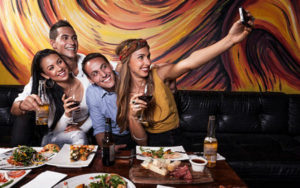All restaurant workers have at some point been innocent victims of irate guests who can’t get what they want. Dealing with the fallout from having to say no may be the most consistent and nerve-wracking part of working in the service industry. It’s the root of the majority of customer complaints. You wanted something, and we wouldn’t do it. These misguided feelings arise from the idealism of the American consumer—who has always been taught that paying “hard-earned” money for goods and services entitles you to have everything your way. If a restaurant refuses to meet your demands then you can simply take your appetite elsewhere.
While it’s true that all guests deserve to be treated hospitably, people’s demands are often unreasonable and they have a tendency to communicate them with an improper tone. So many restaurant experiences become hostage situations when people can’t accept no for an answer. I’ve witnessed people walk out because of it. Being told no turns grown adults into sulky little children. Go ahead, throw a tantrum. Ask to speak with the manager. They may kowtow to pacify you but is it worth being branded a troublemaker? Most of the time, there are legitimate reasons why your server wouldn’t deliver what you’ve asked for and showing deference pays dividends.

What is often overlooked is the currency you earn for being compliant. Good service requires sacrifices on both ends, and restaurant staffs prefer to take care of people who respect the rules. Not only that, many restaurants work hard to cultivate an obedient clientele, pruning out insurgents. The friction you create by pulling the “customer is always right” card may be a threat to your good standing.
A guest recently asked me: “Do you have a problem with that?” when I gave her negative feedback on her unorthodox order. I was gently questioning her demand that each shared appetizer be served one at a time. There were four people seated at the table and it was impractical to serve it this way. My intentions were good—what I thought to be in the best interests of the table. She perceived me as being inflexible. In the end, she got what she wanted but not without compromising our relationship. I was following protocol. She was just rude. Rude people should not expect their server’s affections.
Most controversial restaurant rules are aimed at the overall health of the dining room, not just your table’s. Placing an order incrementally, for example, wreaks havoc on the kitchen and the timing of other tables may suffer on your account. We owe it to those other tables to prevent you from doing it. Asking you to stow your laptop is a courtesy you obviously don’t realize you should extend your neighbors. The light emitting from it disrupts the ambience we work hard to create for everyone. Oh, you don’t like the music choice too? Well, that’s unfortunate but do you honestly think that we can find one genre of music that will appeal to everyone? Even Pandora’s algorithms aren’t that advanced yet.
When you oppose these rules, you send a message that you put your needs above everyone else’s. Being agreeable, on the other hand, reinforces a positive relationship with the people serving you and builds the foundation for a more fruitful experience. You have to choose your battles wisely. Nitpicking about restaurant policies isn’t worth becoming an enemy of the state. Restaurant people don’t forget faces, and it’s up to you whether we remember yours fondly. If you end up in the doghouse, it isn’t very easy to get out.



 Smartphone cameras empower diners to capture more than just food they dine out. One night, while artfully reciting the desserts to a table, a woman stopped me mid-sentence, shoved her phone in my face and asked me to repeat my entire presentation for the camera. When I demurred, she treated me like I was being rude. Having a phone in your pocket that can capture video means your waiter owes you a private performance you can broadcast on Snapchat? Is that what constitutes attentive service in the Age of Social Media?
Smartphone cameras empower diners to capture more than just food they dine out. One night, while artfully reciting the desserts to a table, a woman stopped me mid-sentence, shoved her phone in my face and asked me to repeat my entire presentation for the camera. When I demurred, she treated me like I was being rude. Having a phone in your pocket that can capture video means your waiter owes you a private performance you can broadcast on Snapchat? Is that what constitutes attentive service in the Age of Social Media?